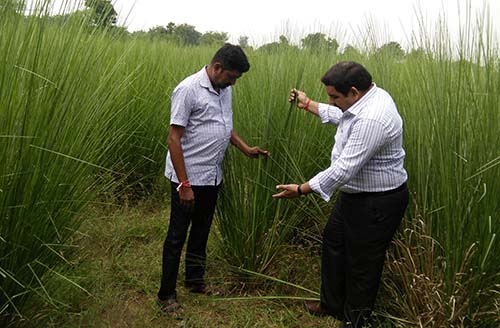KS1, CIM-Vriddhi (CSIR-CIMAP), CIM-Khusnolika
KS1 (CSIR-CIMAP)
CIM-Vriddhi (CSIR-CIMAP)
Chrysopogon zizanioides (Vetiver or Khus), a perennial, aromatic plant growing across India in variable agro climatic conditions, is being used as a source of aroma in India since time immemorial. Roots of vetiver are the source of world famous “Khus oil” which has considerable value in essential oil industry. The total world production of khus oil is estimated to be 250-300 tonnes per year. In India, about 20-25 tonnes of oil is produced annually, which is much below the indigenous demand levels of the oil for perfume, essence, attar and soap industries. Khus can tolerate upto 9.5 pH, drought, submergence for 15 days, and is also highly tolerant to soil sodicity as compared to other agricultural crops. The crop yields around 15-25 kgs of essential oil from one hectare (depending on soil conditions) with a net annual income of around Rs.1.5 - 2 lakhs/ha.
Vetiver can be planted in all types of climates except temperate. The crop prefers tropical and subtropical climate for its proper growth, development and essential oil yield. It grows luxuriantly in places with annual rainfall of about 100-200 cm and temperatures around 30°-40° C with moderately humid climate. In low rainfall areas, it can be grown as an irrigated crop. Vetiver is able to survive in extreme climatic conditions including prolonged drought, flood and temperatures of -3°C to 56°C.
Although the plant grows in all kinds of soils, a rich well-drained sandy loam is considered best. It can be planted in upto 9.5 pH soil and water logging conditions. It may be planted in rainfed conditions as well. Red lateritic soils with good organic matter are considered ideal as the roots produced in such soils are thick and contain more essential oil but heavier clay soils should be avoided. It can grow in soils with high acidity, salinity and alkalinity. Vetiver tolerates very high levels of aluminium, manganese and a range of heavy metals in the soil.
Vetiver slips are taken from mature plants of 6-12 months age and usually 25-30 slips can be obtained from a healthy clump of one year.
Generally, Vetiver is transplanted in July-August with a spacing of 60x30 cm. For higher income generation, farmers can plant wheat in October-November and mints during February. They need to be well watered for the first few weeks until they are established.
Gaps must be filled within one month.
Fertilise with sufficient amount of organic fertiliser at the time of planting. FYM 10-15 t/ha and 80-100 kg Nitrogen, 50-60 kg phosphorus and 40-50 kg potash are desirable for 1 hectare. Nitrogen may be applied at four intervals of 30, 60, 90 and 120 days of planting.
Just after transplanting, irrigation is desirable and subsequent irrigations should be done once in a month as per availability of water.
The crop should be weed-free for at least 2-3 initial months which are critical for its growth.
No serious disease or pests have been reported so far.
Digging of the roots is generally carried out after 10-12 months during winters.
The roots should be washed and dried for at least 2-3 days. The roots are distilled for 24-30 hours in the modified field distillation units.
One hectare of crop yield 20-25 quintal of roots from which 20-25 kg oil will be obtained.
Cost of cultivation : Rs. 1,50,000/ha
Gross return : Rs. 4,00,000/ha
Net profit : Rs. 2,50,000/ha
Under rainfed conditions, planting should be done at a spacing of 40X30 cm and fertiliser should be reduced to 50% and should be applied during rainy season only.
After one year of plantation, each clump yields about 25 to 30 slips.




